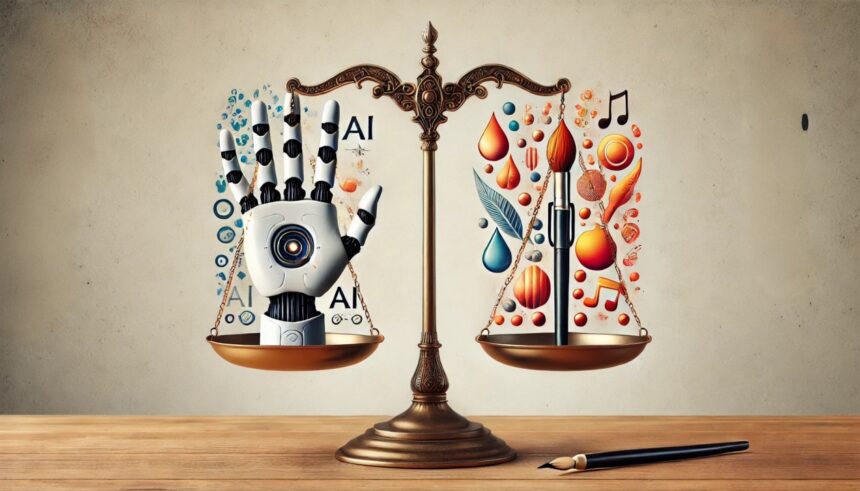Artificial Intelligence (AI) is reshaping industries worldwide, and its influence extends deeply into the realm of intellectual property (IP) law. From creating music, art, and literature to developing groundbreaking algorithms and technologies, AI is challenging traditional concepts of ownership, authorship, and protection. As the legal community grapples with these transformative changes, the intersection of AI and IP law emerges as a crucial frontier for innovation, regulation, and dispute resolution.
Understanding AI’s Role in Intellectual Property
AI systems today can independently create works that were once the exclusive domain of human creators. For example:
- Creative Works: AI-generated content spans music compositions, paintings, novels, and even video games. Tools like OpenAI’s DALL·E and ChatGPT have demonstrated AI’s ability to produce high-quality creative outputs.
- Inventions: AI can design new products, develop complex algorithms, and solve technical problems faster than human counterparts.
- Data and Analytics: AI processes vast amounts of data, leading to insights and innovations that can underpin new intellectual property.
This capability of AI to function as a creator raises fundamental questions: Can AI be considered an inventor or author? If not, who owns the rights to AI-generated works—the developer, user, or company deploying the AI?
Authorship and Ownership of AI-Generated Works
The Human Authorship Requirement
Traditionally, intellectual property law requires human authorship. For instance:
- Copyright: U.S. copyright law stipulates that protection is granted to “original works of authorship” fixed in a tangible medium. Courts have historically rejected claims for works created without human intervention, such as a photograph taken by a monkey (the famous Naruto v. Slater case).
- Patents: The U.S. Patent and Trademark Office (USPTO) mandates that a human must be listed as an inventor in a patent application.
AI-generated works challenge these principles. When AI creates a novel piece of music or designs a complex invention without direct human involvement, existing laws struggle to determine authorship and ownership.
Ownership Disputes
Even when humans are involved in the process, disputes can arise over ownership:
- Developers vs. Users: Developers of AI systems may claim ownership of outputs as extensions of their software, while users may argue that they directed the AI’s actions and should own the results.
- Collaborations: In scenarios where humans and AI co-create, determining the relative contributions of each party complicates traditional copyright frameworks.
Patentability and AI Inventions
Can AI Be an Inventor?
The question of whether AI can be an inventor has reached courts worldwide. The case of Thaler v. Commissioner of Patents involved an AI named DABUS that created inventions without human intervention. Courts in the U.S., UK, and EU have largely held that only humans can be listed as inventors on patent applications. However, these rulings leave unresolved questions about the treatment of AI-driven innovations.
Novelty and Non-Obviousness Challenges
AI also affects the standards of patentability:
- Novelty: AI’s ability to scan vast datasets might lead to innovations that are technically novel but lack human creativity.
- Non-Obviousness: The non-obviousness criterion becomes harder to evaluate when AI generates inventions through processes that might appear obvious to machines but are groundbreaking from a human perspective.
Patent law must evolve to address these nuances, ensuring that genuine AI-driven innovations receive protection without stifling competition.
Copyright Law and AI-Generated Content
Protecting AI-Created Works
One major debate revolves around whether AI-generated works qualify for copyright protection. While current laws exclude non-human authorship, denying protection might discourage the development of creative AI technologies. Proposals to amend copyright law include:
- Granting limited rights to AI-generated works.
- Assigning ownership to the entity or individual who programmed or trained the AI.
The Fair Use Doctrine
AI systems often rely on large datasets for training, raising questions about the use of copyrighted material. The fair use doctrine permits limited use of copyrighted works for purposes like research or education. However, training AI on copyrighted content for commercial purposes stretches the boundaries of fair use, leading to litigation and calls for regulatory clarity.
Trademarks and AI’s Role
AI in Branding and Marketing
AI tools are increasingly used in creating brand names, logos, and marketing strategies. While this expands the creative potential of businesses, it also leads to challenges:
- Trademark Infringement: AI might inadvertently generate content resembling existing trademarks, raising infringement concerns.
- Distinctiveness: Trademarks must be distinctive to receive protection. AI-generated marks might face scrutiny if they are deemed too generic or similar to existing marks.
Data and Trade Secrets in the AI Era
Data as a Valuable Asset
AI systems thrive on data, often using proprietary datasets to gain competitive advantages. This reliance on data raises IP concerns:
- Ownership of Data: Disputes over ownership of datasets used in AI training are becoming more common.
- Trade Secrets: Companies may protect their AI algorithms and data under trade secret laws, but maintaining confidentiality can be challenging in collaborative environments.
Reverse Engineering and AI
Reverse engineering AI systems to understand their functionality is another contentious issue. While reverse engineering is allowed under certain circumstances, it could expose trade secrets and undermine competitive advantages.
Global Perspectives on AI and IP Law
Differing Jurisdictions
The treatment of AI-generated IP varies globally:
- United States: Maintains a strict human authorship requirement but is exploring potential reforms through USPTO initiatives.
- European Union: Emphasizes harmonization of IP laws across member states, with ongoing debates about protecting AI-generated works.
- China: Has taken steps to grant copyright protection to certain AI-generated content, positioning itself as a leader in AI regulation.
International Treaties
Global treaties like the Berne Convention and the Agreement on Trade-Related Aspects of Intellectual Property Rights (TRIPS) were drafted long before AI’s rise. Updating these frameworks to reflect AI’s impact on IP law is crucial for fostering international cooperation and reducing jurisdictional conflicts.
Ethical and Policy Considerations
Beyond legal questions, the intersection of AI and IP law raises broader ethical and policy issues:
- Encouraging Innovation: Striking a balance between protecting AI-generated IP and ensuring public access to AI-driven technologies.
- Accountability: Ensuring that creators, developers, and users of AI are held accountable for misuse or infringement.
- Equity: Preventing monopolization of AI technologies by a few entities, which could stifle innovation and limit access for smaller players.
The Road Ahead: Adapting IP Law for AI
The rapid evolution of AI demands proactive legal reforms. Potential steps include:
- Amending IP Laws: Introducing provisions to address AI-generated works and clarify ownership and authorship.
- Developing International Standards: Establishing consistent global standards for AI and IP law to minimize cross-border disputes.
- Fostering Collaboration: Encouraging collaboration between legal experts, technologists, and policymakers to develop adaptive frameworks.
Conclusion
AI is revolutionizing intellectual property law, challenging long-held assumptions about authorship, ownership, and protection. While current laws provide some guidance, they often fall short of addressing the complexities introduced by AI-generated works and innovations. As technology continues to advance, adapting IP frameworks will be essential to ensure fairness, innovation, and accountability in this new frontier. By embracing change and fostering dialogue, the legal community can navigate the challenges of AI and unlock its potential for societal benefit.







